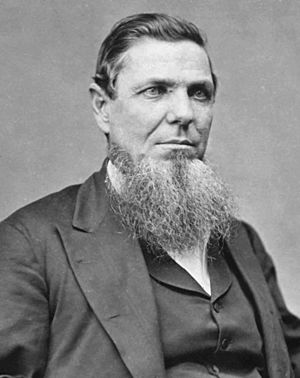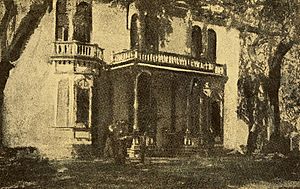Andrew Jackson Hamilton facts for kids
Quick facts for kids
Andrew Jackson Hamilton
|
|
|---|---|
 |
|
| 11th Governor of Texas | |
| In office June 17, 1865 – August 9, 1866 |
|
| Appointed by | Andrew Johnson |
| Lieutenant | Vacant |
| Preceded by | Pendleton Murrah |
| Succeeded by | James W. Throckmorton |
| Member of the Texas House of Representatives | |
| In office 1850–1853 |
|
| Member of the U.S. House of Representatives from Texas's 2nd district |
|
| In office March 4, 1859 – March 3, 1861 |
|
| Preceded by | Guy M. Bryan |
| Succeeded by | John C. Conner |
| Attorney General of Texas | |
| In office January 15, 1850 – August 5, 1850 |
|
| Governor | Peter Hansborough Bell |
| Preceded by | Henry Percy Brewster |
| Succeeded by | Ebenezer C. Allen |
| Personal details | |
| Born | January 28, 1815 Huntsville, Alabama, U.S. |
| Died | April 11, 1875 (aged 60) Austin, Texas, U.S. |
| Political party | Democratic (until 1858) Independent Democrat (1858–1860) Unionist (1860–1866) Republican (1866–1869) |
| Spouse |
Mary Jane Bowen
(m. 1843) |
| Profession | Lawyer |
Andrew Jackson Hamilton (born January 28, 1815 – died April 11, 1875) was an important American politician in the mid-1800s. He was a lawyer and served as a state representative. He also became the 11th Governor of Texas during a time called Reconstruction, right after the American Civil War.
Contents
Early Life and Law Career
Andrew Jackson Hamilton was born in Huntsville, Alabama, on January 28, 1815. He studied law in Alabama and became a lawyer in Talladega, Alabama.
In 1846, Hamilton moved to Texas to join his older brother, Morgan. He opened his own law office in La Grange, Texas. Three years later, he moved to Austin, Texas, to start his political career.
Political Journey
Starting in Texas Politics
In 1849, the Governor of Texas, Peter H. Bell, chose Hamilton to be the acting state attorney general. This was an important legal job for the state.
In 1850, Hamilton was elected to the Texas House of Representatives. He represented Travis County as a member of the Democratic Party. He served one term, leaving office in 1853.
During this time, he joined a group called the "Opposition Clique." These were southern politicians in the Democratic Party who did not agree with states leaving the United States. They also opposed bringing back the slave trade.
Serving in Congress
In 1858, Hamilton was elected to the United States House of Representatives. He represented the western part of Texas as an Independent Democrat. This meant he was a Democrat but sometimes voted on his own.
In late 1860, he joined a special committee in the House. This committee tried to solve the growing problems between the North and South, which eventually led to the Civil War. Hamilton chose not to run for re-election in 1860.
Supporting the Union
When Hamilton returned to Texas in 1861, he won a special election to the State Senate. However, he had to resign from this job. He received threats because he spoke out in favor of the Union, which was the side that wanted to keep the United States together.
In July 1862, Hamilton had to leave Texas and fled to Mexico.
During the American Civil War, Hamilton strongly supported the Union. After leaving Texas, he traveled around the Northeast. He gave speeches in cities like New York and Boston. He spoke about supporting the Union and criticized the "slave power" in the South. Because of this, people in the North saw him as a hero. However, many people in Texas saw him as a traitor.
In late 1862, President Abraham Lincoln named Hamilton the Military Governor of Texas. He was given the rank of brigadier general. He held this position in New Orleans for the rest of the war, but it was mostly a title because Union forces failed to capture South Texas in 1863.
Governor of Texas
On June 17, 1865, after the Civil War ended, President Andrew Johnson appointed Hamilton as the temporary civilian governor of Texas. Hamilton was governor for 14 months during the early part of Reconstruction. This was the period when the country was rebuilding after the war.
During his time as governor, the nation approved the Thirteenth Amendment. This amendment ended slavery and gave economic freedom to formerly enslaved people. Texas itself did not officially approve this amendment until 1870.
Hamilton faced many challenges as governor. There were problems with Native American raids, general lawlessness, and a very messy financial situation after the war.
When his plans for the Constitutional Convention of 1866 were not accepted, he disagreed with President Johnson's plan for Reconstruction. Hamilton then sided with the Radical Republicans. This group wanted stronger protections for African Americans and more changes in the South. He spoke in favor of black suffrage, which meant allowing African American men to vote.
In September 1866, Hamilton helped organize a meeting in Philadelphia where he criticized President Johnson. He resigned as governor in 1867 and later became a judge in New Orleans. That same year, he became a justice on the Texas Supreme Court.
Hamilton tried to become governor again in the election of 1869, but he lost to Edmund J. Davis.
After Being Governor
After leaving the governor's office, Hamilton joined the regular Republican Party. He served on the Texas Constitutional Convention from 1868 to 1869. He also served on the Republican National Executive Committee.
Later, he changed his mind about black suffrage and no longer supported it. After losing the 1869 election for governor, Hamilton led the Tax-Payers' Convention in 1871.
Andrew Jackson Hamilton died in Austin, Texas, on April 11, 1875. He passed away from tuberculosis. He is buried at Oakwood Cemetery in Austin.


